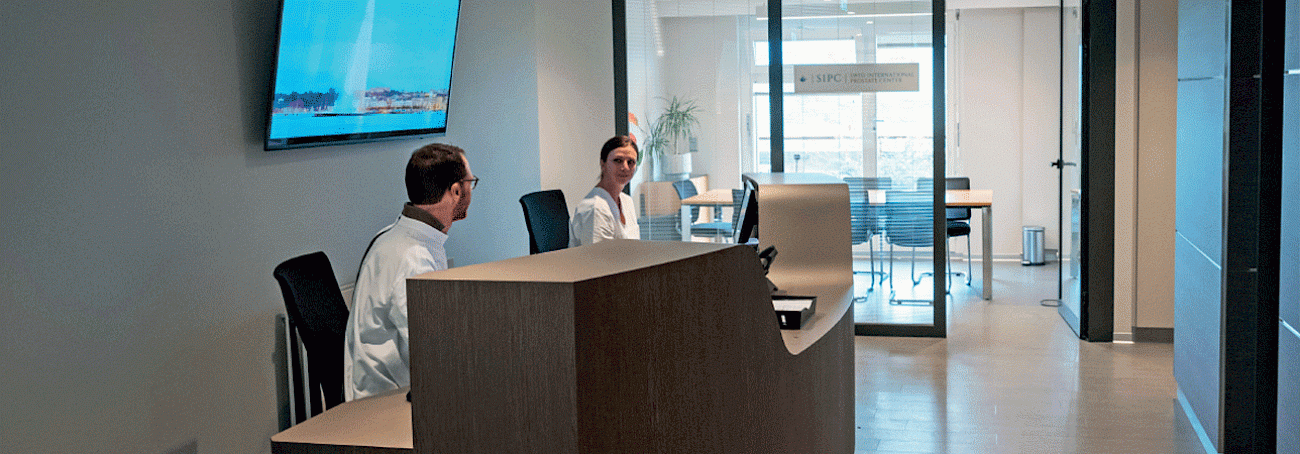Prostate cancer is the most common cancer in men over 50. It usually progresses slowly and only becomes metastatic after several years. The age at diagnosis is therefore of crucial importance.
Cancer is defined as the uncontrolled growth of cells that invade the surrounding tissue. These cells can also migrate to other organs, i.e. metastasis. Prostate cancer usually starts in the outer part of the gland. For this reason, abnormalities can be felt from the rectum. If left untreated, prostate cancer can lead to swelling of the legs due to obstruction of lymphatic drainage, bone pain, but also to kidney failure and eventually death.
Early detection is recommended for men over 50 years of age (45 years if there is a family history of prostate cancer) whose life expectancy is over 10 years. In patients over 75 years of age, screening for prostate cancer is no longer justified, as the survival benefit of treatment is usually only seen after 10 years, due to the slow progression of this cancer.
The prostate
The prostate is a gland that produces a secretion that is released through the urethra, along with seminal fluid and sperm, during ejaculation. This secretion accounts for about one fifth of the volume of the semen. The prostate consists of an outer glandular layer (70 % of the prostate volume) and an inner glandular core (30 % of the prostate volume). As the prostate lies in front of the rectum, a relatively large area of the gland can be palpated by the rectal exam.
Cause of prostate cancer
The cause is unknown, some risk factors have been identified: age, eating habits, heredity. If a first-degree relative (father or brother) has prostate cancer, the risk is multiplied by 2. This risk is increased in the West, probably due to the relatively high consumption of red meat and animal fats.
The tests
Neither the PSA (Prostate Specific Antigen, a protein secreted in the blood) nor the digital rectal exam can prove the existence of prostate cancer. The diagnosis can only be formally established by a tissue sample (biopsy). MRI (Magnetic Resonance Imaging) is an essential step in determining the location of the suspected area within the prostate. Based on the images obtained and by merging them with the ultrasound, the prostate biopsy will be performed with great precision on an outpatient basis, under local anaesthesia or with light sedation. The biopsy is used to establish a tumour grade, i.e. the degree of aggressiveness (Gleason score), on the basis of which treatment will be proposed.
Types of treatment
There are two very different situations with prostate cancer: localized, locally advanced cancer and metastatic cancer, which has already spread cells to other organs. Localized cancer can be cured, advanced cancer can be cured but will always tend to escape treatment in the long run. Nowadays, thanks to screening, most newly diagnosed cancers are in the localised, curable stage.
There are three options:
- Active surveillance,
- Surgery,
- Radiotherapy.
The decision depends on a number of factors and is made after careful consideration by the patient and the caregivers. Factors to be assessed include the stage (T) and grade of the tumour (Gleason). The patient's general condition, the patient's history, the methods available and the experience of the doctors, and the patient's personal feelings about the different approaches will be the elements that will allow the treatment to be chosen as calmly as possible.
Active surveillance
Starting with a tumour that does not seem too aggressive (Gleason score <7), small (non-palpable tumour) and with a low PSA (<10), there is no rush. These 3 elements will be regularly re-evaluated (need to repeat biopsies if necessary) keeping in reserve surgery or radiotherapy the day one of the parameters worsens.
- Advantage: no immediate treatment.
- Disadvantage: the worry of living with an untreated cancer, the risk of being caught off guard by a small tumour that has grown close to the capsule and will surreptitiously transgress it. There is also the risk of having missed more aggressive cancerous sites during the first biopsy.
Radical prostatectomy
This operation aims to completely remove the prostate with its envelope (capsule) and the seminal vesicles and requires the bladder to be reconnected to the urinary canal (vesico-urethral anastomosis). The lymph nodes will also be removed. The Urology Centre offers the robot-assisted method (Da Vinci® robot) which is the evolution of laparoscopy by improving the vision and precision of the procedure.
Radiotherapy
Recommended for men over 70 years old, radiotherapy can also be indicated for younger men who have medical contraindications to surgery: cardiac or pulmonary problems in particular. Radiotherapy destroys the cancerous cells using rays directed at the prostate and prostate area. It can be internal (brachytherapy) or external (conformal radiotherapy).
Focal ultrasound treatment (HiFU)
Small, non-aggressive tumours can be treated with the Focal One, a device that focuses ultrasound on the diseased part of the prostate and allows its removal without surgery. The treatment is followed up by MRI scans and PSA measurements using the principle of active surveillance.
The consequences of treatment
The primary goal of treatment is to cure the cancer. At what cost? The prostate and seminal vesicles produce ejaculation, which will disappear completely with the surgical removal of the prostate. Enjoyment is surprisingly preserved, generally a little diminished. As the prostate is surrounded by erectile nerves that run along the posterolateral capsule, both surgical dissection and radiation may damage them. Two years after treatment, about 50 % of men who were sexually active at the time of diagnosis will have erectile difficulties. Nowadays there are many drugs or treatments available to restore an erection that allows penetration. As the prostate is located just above the urinary sphincter, its removal or irradiation may lead to urinary disorders in the form of incontinence or bladder irritation. These risks are reduced with the robot-assisted laparoscopic method. In the case of early prostate cancer, recovery is possible while maintaining continence and the possibility of penetrative sexual intercourse, with or without drug assistance.
Why choose robotic surgery?
Only surgery allows us to know the exact nature and extent of the tumour since the prostate gland once removed will be analysed in its entirety as well as the lymph nodes. The stage of the disease can therefore be accurately determined. The PSA 6 weeks after the prostatectomy should be 0.0 and remain so thereafter. In this situation, the PSA is indisputable and perfectly reliable. If the capsule is exceeded on analysis of the prostate, and the PSA persists or reappears (>0.2), additional radiotherapy at lower doses may provide a second chance of cure.
The quality of the prostate dissection is essential and the robotic technique allows a better vision (3 dimensions) and a better precision (no trembling, articulation of the end of the instruments on six axes with reduction of the movement, and disappearance of the effect of lever arm which one can have with a traditional instrument introduced in the abdominal cavity. This is in addition to the comfortable and ergonomic position of the surgeon sitting at the console, manipulating his instruments in a totally ambidextrous manner and in line with his 3D camera.
This is why prostatectomy performed with the Da Vinci robot has become the surgical technique of choice. Today, more than 85 % of radical prostatectomies in the US are performed with the Da Vinci robot.
Treatment with the robot: the main advantages
Robotic laparoscopy is a so-called "minimally invasive" technique which, thanks to the use of a remote manipulator with a three-dimensional view, makes it possible to recreate the conditions of a conventional operation, but while sitting at a console close to the patient. The improvements brought about by the robot technology are multiple. The main advantages concern both the patient and the surgeon.
For the patient :
- Increased safety
- Precision of dissection
- Small incisions
- Combined benefits of minimally invasive surgery:
- Reduced bleeding
- Reduced infection
- Reduced pain
- Shortened hospital stay and recovery
For the surgeon :
- Exceptional 3D vision
- Easy access to difficult surgical sites
- Ergonomic position
- Precision of the gestures by the reduction of the bleeding, the reduction of the movements and the rotation of the instruments on 6 axes





